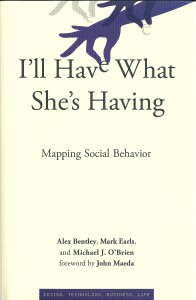The one-sentence summary
Behaviour can be broken down into rational choices or rational guessing, and directed or undirected copying that constitutes social learning.
WHAT THE BOOK SAYS 
- This is an extremely clever book about mapping social behaviour, co-authored by Mark Earls of Herd fame, and two anthropologists.
- It argues that humans are first and foremost social creatures who deploy (often unwittingly) a range of copying strategies to get on in life.
- We are certainly not blindly driven by hard-wired instincts – we know perfectly well how to use the brains of others as storage space for knowledge.
- Cascade models help to explain many decisions, and can be likened to rivers (tributaries), trees (branches), and forest fires (ignition and spread).
- Our social brain thinking can be tree-like, as in recursive language, which allows us to embed seemingly endless sub-bits into the main thought.
- There are many parallels with Darwinian evolution: variation, transmission and selection apply to the spread of ideas as well as genes.
- There are three categories for the evolution of cooperation: group mentality (kin and groups mutually benefit), reciprocity (“I’ll do it if you will”), and reputation (status gain).
- Copying strategies really work, and include: copy the majority, successful individuals, good social learners, kin, friends, and older individuals, and ‘copy if better’.
WHAT’S GOOD ABOUT IT
- Successful elements of social learning can be classified. It works best if people’s direct experience is changed by interaction; if many sparks are lit in the hope of lighting a fire; if the community is small and cohesive; the behaviour has a rationale; and the results are permanently visible and sustainable.
- Their collective behaviour map is really useful:
1. Few people + few similar options = rational choice
2. Few people + many similar options = random guess
3. Many people + few similar options = directed copying (copy if better)
4. Many people + many similar options = undirected copying (what everyone else is doing)
- It is notoriously difficult to change behaviour, but anyone trying to do so should read consider three approaches: 1. Identify what stands out against the background. 2. Focus on the interaction among agents in your population. 3. Learn to predict and cope with turnover.
WHAT YOU HAVE TO WATCH
- This is an extremely intelligent book and, although short and well expressed, you need to be on top of your game to follow it. Concentration is crucial.
